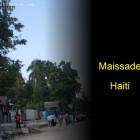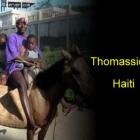ADVERTISEMENT
town - Haiti Observer Blog
town, Haiti Observer Blog. Read the following articles about town
Bellevue la Montagne in Haiti
Bellevue la Montagne is located in region Ouest, Haiti. It is a small place with a very small population that survives under inexplicable poverty. People in Bellevue la Montagne are live examples of what we say, 'life goes on and you just live.' Yes, they just live! La Montagne means 'The Mountain' in French. This explains the geographic location of Bellevue la Montagne which stands at 3000 feet elevation from the coast.
Bellevue la Montagne consists of 3 small villages which include Belleu, Terra Rouge and Le Croix. Living in ultimate poverty, the main livelihood for the people of Bellevue la Montagne is farming. Because of shortage of electricity, water and irrigation facilities, agriculture produces just enough for the farmers to feed their families and if they are lucky, they will have some extra produce that they can sell in local market. There is only one school in Bellevue la Montagne that is located at a distance of 1-1/2 hours and children need to spend 3 hours every day to walking up and down to their school. Only those children go to school whose parents can afford $25 a year.
Read about more Haitian cities and towns....
Arcahaie, Historical Heritage and plantain capital - Li pwodi Anpil Bannann
Haiti has a lot of popular cities and municipalities, one of which is the town of Arcahaie in the Arrondissement of Arcahaie. This town is one of the two that make up the entire arrondissement, while Cabaret is the other municipality. It houses more than 106,500 people and is a recognized town.
Arcahaie nan awondisman Arcahaie. Vil sa a se youn nan de a ki fè moute awondisman an tout antye, Cabaret se lòt minisipalite a. Plis pase 106.500 moun Ap Viv ladan-Li.
Arcahaie's popularity is mainly attributed to its historical heritage, as a lot of significant incidents in the past occurred here. One of them is the memorable 1803 Congress, wherein the unity if Haiti's black people and mulattos was signified. It can be recalled that the country's founding father, Jean-Jacques Dessalines, replaced the French flag with a blue and red flag after tearing it apart during the Congress. It was the first time in three years of revolution that Haiti's unity had been symbolized.
Fort-Liberte In The Nord Department Of Haiti
Fort-Liberté is located in Haiti's Nord-Est-Department. In Haiti, it is the oldest country and Haiti got its independence here on November 29,1803. The Dominican Republic is located close to its border. Around 11,465 people inhabit the place. The language spoken in the region is Creole. Hurricanes, storms and sunshine are all experienced bringing changes in temperature.
How It Got Its Name
Indians inhabited the region originally after which the Spanish colonists came. In 1578 they found the city of Bayaja and in 1605 abandoned it. In 1732 the French reoccupied it as Fort-Dauphin. In 1764, Spanish forces captured it and in 1801 shortly, after independence was declared in 1803, it was restored to the French.
Explore Beautiful Abricots Town In Haiti
Abricots is a beautiful place located in the Jeremie Arrondissement municipality in Haiti's Grand'Anse Department. The town is surrounded by a vast coastal area. All the year through, the climatic conditions are nice and pleasant. Hence the main activity carried out is fishing.
Main Abricots Attractions
Main attraction of Abricots is the exotic beaches where lots of people visit to spend quality time in exploring the beautiful surroundings. Some of the best Haitian cooks prepare seafood with distinguished taste in Abricots. Exclusive seasoning and natural herbs are used for preparing fresh seafood harvested from the sea, the same day. Sugarcane, cacao and coffee are the other crops grown here.
Christianity and Voodoo Co-Habitate in Anse-a-Foleur
In the Nord Ouest Department located within Saint-Louis-du-Nord Arrondissement sits Anse-à-Foleur. Lying just above sea level, it is home to a population of 18,100 inhabitants.
Locals in Anse-à-Foleur follow the officially recognized creed, Christianity. But as is common in other Haitian communities, Voodoo also exists. The village is home to a Voodoo church that contains many maze-like corridors, and the fenced-in area outside contains a pond, filled with dirty water at mid-calf level. The purpose of the pond is to purify sins, a Christian concept.
To give some background on how the practice of Voodoo and Christian concept of sin came to be associated, it begins with the immigration of Congolese slaves to Hispaniola. The slaves brought with them their belief in the Loa, a supreme deity who possesses the bodies of chosen aspirants. To be possessed by the Loa is an honor, and ritual dances with chickens and Voodoo drums entice the Loa to appear. When European settlers seized control of Hispaniola, they forbade the pagan practice of Voodoo. But Voodoo shamans found aspects of Christianity appealing, and began incorporating them into their ceremonies. Today Christian and Voodoo believers live in harmony.
Government of Haiti's Favorite Child, Bas-Peu-de-Chose
Bas-Peu-de-Chose is a community for rich Haitians. A quiet neighborhood, each block contains only a handful of properties, with fenced-in yards, land-scaped lawns, and fruit trees. Inhabitants are government ministers, doctors, clergy, military, and relatives of highly-placed government officials.
Some of the homes are modest, others palatial, survivors of the colonial period. But all contain one, or several varieties of trees, among them cherry, breadfruit, grape, orange, and coconut. Birds abound, pecking at the dew-moistened grass in the early mornings.
Besides the verdant environment, one other element sets the neighborhood apart from many communities in Haiti, the paved roads. Why this particular anomaly in Bas-Peu-de-Chose? Haiti is a country so poor it occupies a permanent spot on the failed states index. One does not need to look far for the answer. Bas-Peu-de-Chose is the government of Haiti's (GOH) extended family of retired government ministers, military officers, and mothers of ex-presidents.
First Community to Receive Food Aid in Derac, Haiti
Haiti is on the verge of a national food crisis. Ministry of Public Health and Population has issued warnings to government of Haiti (GOH) an impending food shortage is threatening to afflict millions of poor Haitians across the nation. In response, GOH, with help from welfare-assistance agency, Ede Pép, is starting a food-canteen program.
Its first beneficiary, Derac village, received a visit from Minister of Social Affairs and Labor, Charles Jean-Jacques, in April. Accompanied by Northeast Departmental Delegate, Charles Hugo, they handed out food-pantry items to slightly more than a thousand inhabitants of the community. A food canteen serving one hot meal a day will follow as soon as Petrocaribe releases funding to Ede Pép.
Coteaux and the Miraculous Virgin
The town of Coteaux is the capital of the Arrondisement of Coteaux in Haiti's Sud Department. However, it is not the only reason why many people throng to the town every now and then. A high number of believers often go to the town in order to pray to the Miraculous Virgin in Coteaux.
It is believed that the Virgin hears and grants the prayers of believers, especially women. In order to reach the shrine where the Miraculous Virgin can be found, people have to pay a pilgrimage and climb a 500-step stair. Going to the shrine through the long stair is almost the same as scaling the popular Great Wall of China.
Port-A-Piment and The River That Runs Through
The town of Port-a-Piment in the Sud Department is one the municipalities where the Rivieres de Port a Piment goes through. There are about 13,900 people living in Port-a-Piment and they get affected when the river overflows. It is common for the river to cause floods during the rainy season. When it happens, the dirt roads become submerged, making it impossible for people to use them. Roads are often closed down when the river overflows.
It can be recalled that in 2011, two people were reported to have been swept away when the river overflowed. Around 70 families in the villages of Chantal and Corteaux were also affected by the disaster, which destroyed their homes. During that time, people were forced to relocate.
Thiotte offers best Haitian Coffee
Residents in the town of Thiotte in the Arrondissement of Belle-Ense heavily rely on the town's booming coffee industry. Many residents here are coffee farmers who get support from an organization called Root Capital. Under its small-business model program COOPCAB, rural farmers work together in order to increase and ensure the quality production of coffee beans. Coffee farmers in Thiotte grow Arabica beans.
Rural farmers also receive around 100,000 coffee and tree seedings from COOPCAB and this supply allows them to maintain production. Not only that, COOPCAB also encourages Thiotte farmers to follow sustainable farming practices so that the production of coffee in the town remains strong and steady.
Our objective is to share with you news and information about Haiti and the people of Haiti. Traditions, habits and the way we were or grew are alive in this site. We highly recommend that you Subscribe to our Newsletter and also share with us some of the things that are memorable and made us unique people.

 Informative Marketing and Advertising in the Haitian Community
Informative Marketing and Advertising in the Haitian Community  Maissade, Haiti
Maissade, Haiti  Haitians are a Proud People
Haitians are a Proud People  Haitian Thanksgiving
Haitian Thanksgiving  Thomassique, Haiti
Thomassique, Haiti